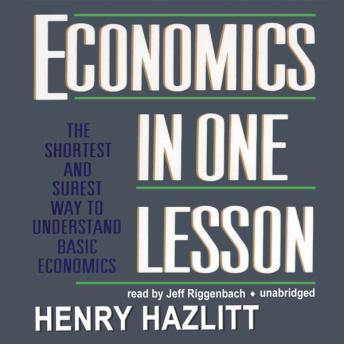3 Economic Fallacies That Just Won’t Die
Henry Hazlitt discussed, dissected, and debunked 22 economic sophisms in his classic work ‘Economics in One Lesson.’
In any academic discipline, one can find two types of experts: those who are incapable of explaining complex ideas in a simple manner; and those capable of making the difficult look easy. This year marks the 25th anniversary of the death Henry Hazlitt, one of the few economists who belongs to the second group.
Born in Philadelphia in 1894, Hazlitt developed his career as a journalist in the most influential newspapers and magazines of the country, starting at The Wall Street Journal as a typographer in 1914. During the 1920s, he wrote for several printed media outlets, including The New York Evening Post and The Nation, of which he was appointed literary director.
Hazlitt pointed out that short-sighted economic policies aimed at satisfying the claims of particular groups end up reducing the welfare of the majority.
In 1934, Hazlitt became the chief editorial writer of The New York Times, where he gained a reputation for writing about economics and finance from a free-market perspective. His outspoken opposition to the Bretton Woods Agreement had him fired after 12 successful years at the most important newspaper of the Big Apple. Yet he continued to be dedicated to his passion for writing until his death in 1993.
Despite his lack of formal academic training, Hazlitt showed a deep interest in the field of economics, which led him to write several books on the topic. In 1946, he published one of the best introductory texts on economics ever written: Economics in One Lesson.
Following the steps of the 19th-century French economist Frédéric Bastiat, Hazlitt pointed out that short-sighted economic policies aimed at satisfying the claims of particular groups inevitably end up reducing the welfare of the majority of the population. In his own words,
“The art of economics consists in looking not merely at the immediate but at the longer effects of any act or policy; it consists in tracing the consequences of that policy not merely for one group but for all groups.”
Economics in One Lesson is a magnificent rebuttal of popular economic fallacies deeply embedded in the political discourse of his time. By means of a very accessible language aimed at the general public, Hazlitt discusses, dissects, and debunks 22 economic sophisms like the idea that technological advances destroy employment or the myth that price ceilings are beneficial for consumers. All fallacies examined in Economics in One Lesson are still present in today’s political debate. Yet there are some that are especially relevant for their implications on the long-term welfare of societies. Here are three of them:
- The Protectionist Fallacy
Since at least Adam Smith, it is a well-known fact that free trade is one of the keys to prosperity. Yet the case for tariffs keeps coming back like a bad penny. In a few pages, Hazlitt provides a concise and yet comprehensive account of the detrimental effects of tariffs on real wages, consumers, and productivity. According to Hazlitt, this fallacy stems from looking merely at the short-term benefits of tariffs for specific groups disregarding their long-term impact on the economy as a whole.
- The Minimum Wage Fallacy
The myth that lower classes benefit from minimum wage laws is another belief firmly rooted in the collective imagination of the public. Nothing could be further from the truth. When the government passes a law forbidding employers from paying workers less than, say, $15 per hour, all workers whose marginal productivity doesn’t reach that number will be condemned to unemployment. As put by Hazlitt,
You cannot make a man worth a given amount by making it illegal for anyone to offer him anything less. You merely deprive him of the right to earn the amount that his abilities and situation would permit him to earn.
- Labor Unions Raise Wages and the Standard of Living
Another widely-spread fallacy has to do with the role of labor unions in determining real wages. According to the conventional view, labor unions play an essential role in settling the overall level of wages in an economy. In other words, most workers would be underpaid if unions didn’t exist. It is true that labor unions can push wages above productivity in a particular industry in the short term.
The ideas of Henry Hazlitt should be vindicated as a means of fighting the basic economic fallacies of our time.
However, the increase in labor costs will be likely passed to consumers in the form of higher prices, which will end up reducing the volume of profits of the industry as a whole. This, in turn, will result in lower wages and, ultimately, unemployment. Thus, labor unions cannot affect the wage level in the long term. For Hazlitt, the fallacy resides in overlooking the only source of long-term increases in real wages: developments in labor productivity as a result of “the accumulation of capital and the enormous technological advance made possible by it.”
In a time when protectionism and minimum wage laws are on the front line of the political arena, the ideas of Henry Hazlitt should be vindicated as a means of fighting the basic economic fallacies of our time, which unfortunately have barely changed since the publication of Economics in One Lesson. Hazlitt taught us that, in economics, intuition is misleading and reasoning beyond the obvious is the only way to gain a deep understanding of the long-term consequences of economic policies.
Reprinted from Intellectual Takeout.
Luis Pablo De La Horra holds a Bachelor’s in English and a Master’s in Finance. He writes for FEE, the Institute of Economic Affairs and Speakfreely.today.

